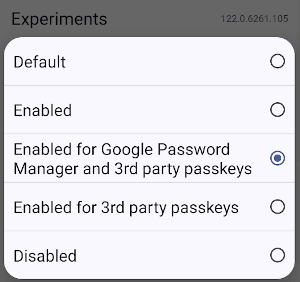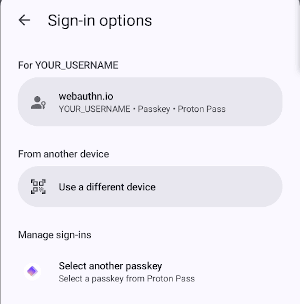How to use Proton Pass passkeys
Passkeys allow you to authenticate yourself for online accounts without using passwords or passphrases. Currently, passkeys are supported in our browser extension and on Android and iOS devices.
Note: Firefox doesn’t yet offer passkey support on iPhones and iPads.
Read more about passkeys and how they work.
This guide only covers creating passkeys. To manage them, you can follow the same steps as any other Proton Pass item. We also have guides on how to use Proton Pass browser extension, the web app, Android devices, and iPhones/iPads.
- How to use Proton Pass passkeys in the browser extension
- How to use Proton Pass passkeys on Android
- How to use Proton Pass passkeys on iPhone
How to use Proton Pass passkeys in the browser extension
To create a new passkey, go to a site that supports them and either create a new account with a passkey or find the security settings for an existing account. There, click on Create passkey (exact text may differ depending on the website). Below is an example from GitHub.

Proton Pass will prompt you to save the passkey through a pop-up in the top right of your screen. Click on Save passkey.

Some services will prompt you to name the passkey. We recommend doing so.

Next time you access the site, Proton Pass will prompt you to enter using your passkey. Just click on the passkey and you’ll be authenticated without needing to do anything else.

Note that you can have multiple passkeys for the same site; they will all be displayed in the same pop-up, and you can choose which to use.

How to use Proton Pass passkeys on Android
To create a passkey on an Android device, make sure you’re using Android 14, as earlier versions do not support passkeys. (Previously, Google only allowed Google Password Manager in Chrome to handle passkeys on Android.)
Additionally, certain smartphone makers, such as OnePlus and Oppo, haven’t added support for passkeys to their devices.
Finally, Samsung smartphones have a known issue where they display a gray square instead of Proton Pass.
Any passkeys you have already saved for apps should work, but you need to go through some steps to set up passkeys in your mobile browser.
Reminder: Firefox doesn’t offer passkey support. You can follow its tracking issue ticket(new window).
To enable passkeys in Chrome for mobile, you’ll need to go to a special menu called Experiments. To get there, type in the address bar:
chrome://flags (for Brave, it’s brave://flags, for Vivaldi, vivaldi://flags, etc.)

Once there, search for passkeys and then enable Android credential management for passkeys.

Confirm this by tapping on Enabled for Google Password Manager and 3rd party passkeys.

With this setup, you can start using passkeys. To do so, go to a website that supports them and find the correct options (this can differ depending on the website). You will be prompted to create the passkey.

With everything set up, the next time you access the website, a prompt will appear asking if you want to log in via passkey. Tap and you will be authenticated. Note that on Android, the logo for Google Password Manager will show. Make sure to check that you’re using Proton Pass before continuing (the name should show at the bottom of your screen).

If you want to use a different passkey or another authentication method, tap Sign-in options at the bottom and you will be offered other possibilities.

Please contact our Support team via the support option in the Proton Pass app if you can’t activate Proton Pass as a passkey provider on your Android smartphone.
How to use Proton Pass passkeys on iPhone
Passkeys are available for all iPhones and iPads from iOS 17 onward. Earlier versions do not support passkeys.
Go to the site you want to create a passkey, click Create passkey or similar wording. Below is a screenshot from GitHub.

A new prompt will ask where you want to store your passkey. Choose Proton Pass.

Proton Pass will launch. Now choose the passkey you want to create, then tap Confirm.

Some sites will give you the option to name your passkey. We recommend you do so.

Next time you try to access the website or service, you’ll be prompted to choose whether you want to do so by passkey or password. You can enter by passkey with a single tap on your screen.

